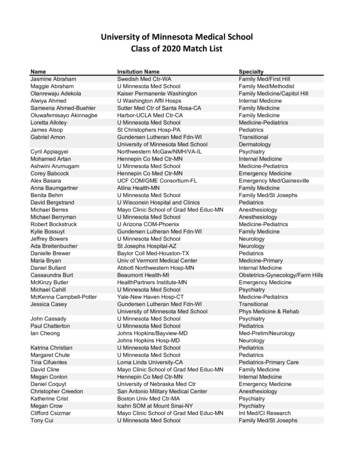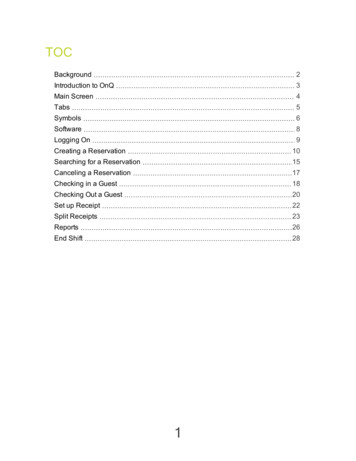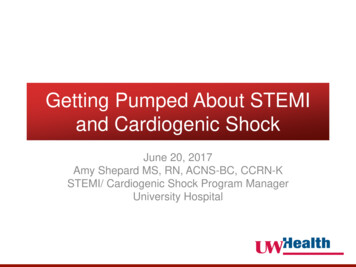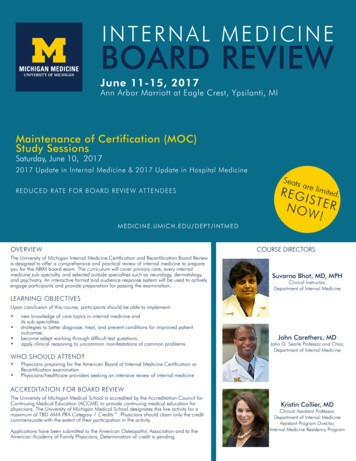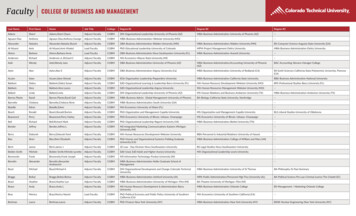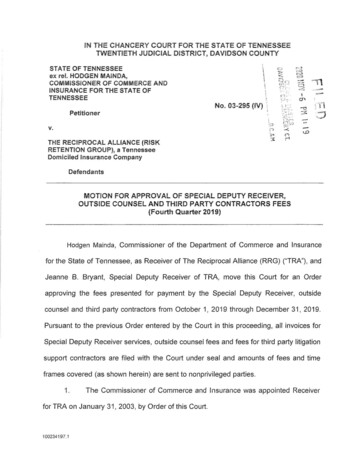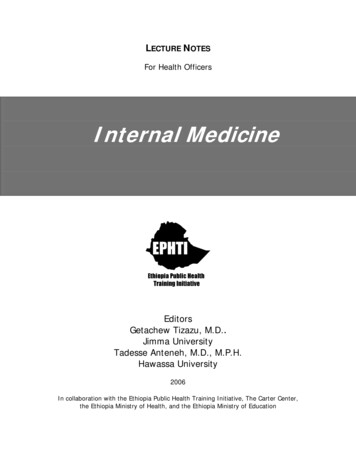
Transcription
LECTURE NOTESFor Health OfficersInternal MedicineEditorsGetachew Tizazu, M.D.Jimma UniversityTadesse Anteneh, M.D., M.P.H.Hawassa University2006In collaboration with the Ethiopia Public Health Training Initiative, The Carter Center,the Ethiopia Ministry of Health, and the Ethiopia Ministry of Education
Funded under USAID Cooperative Agreement No. 663-A-00-00-0358-00.Produced in collaboration with the Ethiopia Public Health Training Initiative, The CarterCenter, the Ethiopia Ministry of Health, and the Ethiopia Ministry of Education.Important Guidelines for Printing and PhotocopyingLimited permission is granted free of charge to print or photocopy all pages of thispublication for educational, not-for-profit use by health care workers, students orfaculty. All copies must retain all author credits and copyright notices included in theoriginal document. Under no circumstances is it permissible to sell or distribute on acommercial basis, or to claim authorship of, copies of material reproduced from thispublication. 2006 by Getachew Tizazu, Tadesse Anteneh, Yoseph Mamo, Zenebe Assefa,Abere Bekela, Woldnecherkos Abebe, Fetih Mohammed, Tesfaye H/Tsion,Girma Tesfaye, and Dejuma YadetaAll rights reserved. Except as expressly provided above, no part of this publication maybe reproduced or transmitted in any form or by any means, electronic or mechanical,including photocopying, recording, or by any information storage and retrieval system,without written permission of the author or authors.This material is intended for educational use only by practicing health care workers orstudents and faculty in a health care field.
PREFACEInternal medicine is a vast and complicated field that is based on strong scientific and clinicalfoundations. Moreover it is rapidly evolving and one needs periodic updating and catching up with thestate of the art knowledge.Providing a comprehensive review of internal medicine is not only difficult but almost impossible, asthe field is vast and extensive. Despite this limitation, the authors have tried to provide a basicframework for working knowledge of Internal medicine. Essential topics are included as much aspossible, and some chapters and topics are dealt extensively, such as Infectious diseases in generaland Acute febrile illnesses, Tuberculosis, and HIV/AIDS in particular, as these are known to be thecommonest causes of morbidity and mortality in developing countries, like ours.Even though a number of individuals have contributed in the original document of this lecture note, asmore than 3 years have elapsed, most of the topics are reviewed, and some topics are completelyrewritten, to include new developments and the state of the art scientific knowledge.This lecture note has been written primarily for Health officer students; however it can also be used bymedical students and all other health science students who deal with patients, who have medicalillnesses.Getachew Tizazu&Tadesse Antenehi
ACKNOWLEDGMENTSThe editors are very grateful to all the medical professionals from Jimma, Hawassa, and HaramayaUniversities, who have contributed in different ways to help develop this lecture note.Our special thanks go to the contributing authors, who took time from their very tight schedules, toprepare the draft lecture notes, in different topics. We sincerely appreciate the effort of the reviewerswho have given their valuable comments and inputs during the initial within University review, and thesubsequent joint reviews conducted at the Carter center, in Addis Ababa.We are mostly indebted to Dr. Akilu Azaje, Assistant professor of Internal medicine, in the departmentof Internal Medicine at the Medical faculty of Addis Ababa University, who has reviewed the first draftlecture note, for his guidance and outstanding comments and valuable inputs.We would like to thank Dr. Tekabe Abdosh, who reviewed some topics of this lecture note.We also thank all the staff of the Carter center, Ethiopia for their hospitable hosting and assistanceduring the development of the lecture note.Last but not least our deepest gratitude extended to Ato Aklilu Mulugeta, for his tremendous effort,close follow-up and contribution in facilitating the completion of this lecture note.Getachew Tizazu, M.D.&Tadesse Anteneh, M.D.ii
CONTRIBUTORSContributorsChapters or Topics contributedGetachew Tizazu, M.D.Infectious diseasesDiseases of Metabolism and the EndocrineSystemAssistant professor of internal medicineFaculty of medical sciences,Diseases of the connective tissue andJointsJimma University( Currently working for Columbia University ICAP –Ethiopia Program)Diseases of the Nervous systemTadesse Anteneh, MD , MPHInfectious diseasesAssistant professor of Internal medicine ,Diseases of the Respiratory systemHealth sciences Faculty ,Diseases of the Gastrointestinal systemHawassa UniversityHematologic diseasesYoseph Mamo, M.D.Diseases of Metabolism and the EndocrineSystemAssociate professor of Internal medicine ,Diseases of the Cardiovascular systemFaculty of Medical sciences,Jimma UniversityDiseases of the Nervous systemZenebe Assefa, M.D.Assistant professor of Internal medicine ,Faculty of Medical sciences ,Jimma UniversityDiseases of the KidneysAbera Bekele, M.D.Assistant professor of Internal medicine ,Faculty of Medical sciences ,Jimma Universityiii
Diseases of the Cardiovascular SystemWoldecherkos Abebe, M.D.Assistant professor of Internal medicine ,Faculty of Medical sciences ,Jimma UniversityFetih Mohammed, M.D.Disease of the Respiratory SystemAssistant professor of Internal medicine ,TuberculosisHealth sciences Faculty,HIV/AIDSJimma UniversityTesfaye H/ Tsion M.D.Sexually transmitted InfectionsLecturer in the department of Internal medicine ,HIV/AIDSFaculty of Medical sciences , Jimma UniversityHematologic diseasesGirma Tesfaye, M.D.Lecturer in the department of Internal medicineGastrointestinal diseasesDejuma Yadeta, M.D.Lecturer in the department of Internal medicine ,Health sciences Faculty , Hawassa Universityiv
Table of ContentsPrefece . .iAcknowledgement . iiTable of Contents . iiiList of tables . viAbbreviation . viiChapter I. Infectious diseases . .11. Introduction to infectious diaseses . .12. Acute Febrile Ilnesses . .42.1. Malaria . .42.2. Typhoid (enteric) fever . .172.3. Relapsing fever . .222.4 Typhus fever . .293. Helmenthiasis and Parasitic Diseases. .343.1 Intestinal Nematodes . .343.2 Tissue Nematodes . .413.3 Filariasis & Related Infections . .433.4 Trematodes : Schistosomiasis . .473.5 Cestodes . .533.6 Leishmaniasis . .564 Tuberculosis . .645 Human Immunodeficiency Virus and AIDS. .796 Sexualy Transmited Diseases . .1307 Other infectious diaseses . .1457.1 Tetanus . .1457.2 Rabies . .1507.3 Anthrax . .1537.4 Brucellosis . .156Chapter II. Disease of the respiratory System . .1591. Common Symptoms of respiratory system . .1592. Upper Respiratory Tract Infection . .164v
3. Pneumonia. .1694. Bronchial Asthma . .1775. Chronic obstructive pulmonary diseases . .1856. Suppurative lung diseases . .1916.1 Bronchiectasis. .1916.2 Lung Abscess . .1937. Pleurisy and pleural effusion. .1958. Neoplasms of the lung . .198Chapter III. Diseases of the Cardiovascular System . .2031.Rhehumatic Fever . .2052.Congestive heart failure. .2103.Valvular Heart Diaseses . .2184.Infective Endocarditis . .2285.Cardiomypathies . .2386.Myocarditis . .2467.Hypertension . .2518.Pericarditis and Pericardial effussion . .2669.Ischemic Heart Diseases and Myocardial Infarction . .27110.Cardiac Arrythemias . .285Chapter IV. Diaseses of the Kidneys . .2921. Introduction to renal diseases . .2922. Acute nephritic syndrome . .2973. Nephrotic Syndrome . .3014. Acute Renal Failure . .3055. Chronic Renal Failure . .3166. Urinary Tract Infection . .327Chapter V. Disease of the Gastrointestinal system. .3371. Approach to patients with GI disorders . .3372. Gastritis and Peptic Ulcer Diseases . .3423. Malabsorption . .3544. Pancreatic Diseases . .3595. Hepatitis . .365vi
6. Chronic Liver Diseases Cirrhosis and Hepatoma . .3737. Diarrheal Diseases . .382Chapter VI. Hematologic Diseases . .3891. Anemia . .3892. Lukemias . .4053. Lymphoma . .4204. Disorders of Hemostasis . .425Chapter VII. Disease of Metabolism and Endocrine System . .4331. Introduction to Diseases of the Endocrine System . .4332. Diabetes Mellitus . .4353. Thyroid diseases . .4554. Diseases of the Adrenal Gland . .4745. Diseases of the Pituitary Gland . .480Chapter VIII. Diseases of the Nervous System . .4911. Headache . .4912. Diseases of the Spinal Cord . .5003. Cerebrovascular diseases /Stroke . .5074. Impairment of Consciousness and Coma . .5155. Seizures and Epilepsy . .5236. Parkinson’s diseases and other movement disorders . .5367. Peripheral Neuropathy . .5478. CNS infections : Meningitis and Encephalitis. .555Chapter XI. Connective Tissue Diseases and Diseases of Joints . .5621. Systemic Lupus Erythromatous ( SLE ) . .5622. Rheumatoid Arthritis . .5663. Other connective tissue diseases : Systemic Sclerosis , Mixed connectivetissue disorders . .5734. Gout . .576vii
LIST OF TABLESTableI-2.1-1 The basic characteristics of the two transmission types of malaria . .6Table I-2.1-2 Types of plasmodium and their clinical features . .9Table I-2.3 -1 The basic characteristics of the two types of borreliae. .25Table I-3.6-1: Important causes of cutaneous leishmaniasis. .61Table I- 4 -1: Tuberculosis Treatment Category . .74Table I- 4-2: Anti TB drugs are classified in to two groups . .76Table I-4-3: Side Effects of common Anti TB drugs and Treatment of side effects .77Table I-5-1. Manifestations of Tuberculosis in early and advanced HIV. .100Table I-5-2. Stages of ADIS dementia complex . .109Table I-5-3. Revised classification system for HIV infection (CDC Classification). .122Table I-5-4. WHO Clinical Staging System for HIV/AIDS . .122Table II-4-1 Comparison of the two major types of Asthma . .178Table II-4-2. Step wise approach for managing Asthma in adults . .183Table II-5-1 Summary of clinical manifestations of Chronic Bronchitis and Emphysema188Table III -1-1 Jones criteria for the diagnosis of acute rheumatic fever . .207Table III -2-1:New York Heart Association Heart Failure Symptom ClassificationSystem. .213Table III-4-1: Frequencies of Occurrence of prominent Clinical and LaboratoryManifestations in Endocarditis . .233Table III -4-2 The Duke Criteria for the Clinical Diagnosis of Infective Endocarditis .234Table III-5-1 Clinical classification of Cardiomyopathies . .239Table III-7-1 Classification of blood pressure for adults and older children . .252Table –III-8-1. Classification of Pericarditis . .267Table V-1-1 Main differences between exudative and transudative ascetic fluids . .339Table V-2-1 Some differences in the clinical manifestations between DU and GU .347Table V-2-2 Regimens recommended for eradication of H. pylori infection . .350Table V -5-1 Comparisons of some features of hepatitis A, B, and C . .368Table V-6-1 Stages of chronic hepatic encephalopathy and their manifestations . .379Table VI-1-1 Criteria of anemia in adults at sea level . .389Table VI-1-2 Difference in between Cobalamine and Folate physiology and dailyRequirement . .401Table VI-2-1 Showing the main features of acute leukemic cells . .411Table VIII-2-3 The treatment of acute leukemias (Cytotoxic drugs & phases of treatment)412viii
Table VI-4-1 Correlation of coagulation factor activity and severity in hemophiliacand factor IX deficiency . .430Table VI-4-2 Comparison between different coagulation disorders . .431Table VII-2-1 Criteria for the Diagnosis of Diabetes Mellitus . . 440Table VII-4- 2 Interpretations of Water deprivation test . .489Table VIII-3-1 Characteristic features of different types of stroke . .510Table VIII-4-1 Glasgow coma Scale . .517Table VIII-5-1 Selection of antiepileptic drugs . .530Table VIII-7-1 Etiologies of neuropathies based the predominant symptoms or signs .547Table VIII-8-1 CSF analysis findings in different types of meningitis . .558ix
ABBREVIATIONS AND ACRONYMSABC – Airway, Breathing, and CirculationABG - Arterial blood gasACTH – Adrenocorticotrophic hormoneADH – Antiduiretic hormoneAFB – Acid fast bacilliAIDS – Acquired Immunodeficiency SyndromeALT/SGPT – Alanine aminotransferaseAMI – acute myocardial infarctionANC – Antenatal careAPOC – African Programme for Onchocerciasis ControlARDS – Adult respiratory distress syndromeARF – Acute rheumatic fever/acute renal failureARTs – Antiretroviral therapiesASO titer – Antistreptolysin O titerAST/SGOT - Aspartate aminotransferaseAV - Atrioventricular or arteriovenousBCG – Bacille Calmette GuerinBF – Blood filmBID – Twice a dayBLCM – Below left costal marginBM – Bone marrowBMI – Body mass indexBP - Blood pressureBPH - Benign prostatic hypertrophyBS – Blood sugarBUN – Blood Urea NitrogenCAD – Coronary artery diseaseCBC – Complete blood countCHF - Congestive heart failureCNS – Central nervous systemx
CPK - Creatine phosphokinaseCR – CreatinineCRF - Chronic renal failureCRH – Corticotrophic hormoneCSF – cerebrospinal fluidCT – Computerized TomogramCTLs – Cytotoxic T LymphocytesCVD – Cerebrovascular diseasesCVS – Cardiovascular systemCXR – Chest x-rayDAT – Direct agglutination testDDI – DidanosineD4T- StavudinDIC – Disseminated intravascular coagulopathyDirect IF – direct ImmunoflourescentDKA – diabetic ketoacidosisDM – diabetes mellitusDNA- Deoxyribonucleic acidDOTS – Directly Observed TB treatment Short courseDW - dextrose in waterEBV- Epstein-Barr virusECF – Extracellular fluidECG – ElectrocardiogramEFV – EfavirenzELISA – Enzyme linked immunosorbent assayEPTB – extrapulmonary tuberculosisESR - Erythrocyte sedimentation rateESRD – End stage renal diseaseETB – EthambutolFBC – Full blood countFBS – Fasting blood glucoseFSH – follicle stimulating hormonexi
GAS – Group A StreptococciGDM - Gestational onset diabetes mellitusGH – Growth hormoneGHRH – Growth hormone releasing hormoneGI - GastrointestinalGIT – Gastrointestinal tractGnTH - Gonadotrophic hormoneGTT - glucose tolerance testHAART – Highly active antiretroviral treatmentHAV - Hepatitis A virusHBV – Hepatitis B virusHCV – hepatitis C virusHDL - high-density lipoproteinHgb – hemoglobinHHV-8 – Human Herpes Virus-8HIV –Human Immunodeficiency VirusHx – Clinical historyICF – Intracellular fluidICU – Intensive care unitIGT- Impaired glucose toleranceIHD – ischemic heart diseaseIM - IntramuscularINH – IsoniazidIV - intravenousIVDU – Intravenous drug useJHR – Jarisch Herxheimer reactionJVP - Jugular venous pressureKS – Kaposi SarcomaKUB –Kidney Ureter BladderLBRF – Louse borne relapsing feverLDH - Lactate dehydrogenaseLDL - low-density lipoproteinxii
LH - Luetenizing hormoneLP – Lumbar punctureLVH – left ventricular hypertrophyMAC – Mycobacterium avium complexMDR – Multidrug resistanceMODY 1, 2, 3 – Maturity onset diabetes of the young 1,2,3MRI – Magnetic Resonant ImagingMTCT – Mother to Child transmissionN/S – Normal salineNCTs – Nerve conduction testNK cells – Natural killer cellsNNN – Nichole MacNeal Novy mediumNSAIDs - Non-steroidal anti-inflammatory drugsOEPA – Onchocerciasis Elimination Programme for AmericasOIs – Opportunistic infectionsOMs – Opportunistic malignanciesP/E – Physical examinationPaO2 – partial pressure of arterial oxygenPCP – Pneumocystis carinii pneumoniaPCR – Polymerase Chain ReactionPFT – pulmonary function testPLWHA – People living with HIV/AIDSPML - Progressive multifocal leukoencephalopathyPMTCT- prevention of Mother to Child transmissionPO – Per os (orally)PPD – Purified protein derivativePTB - pulmonary tuberculosisPTU - PropylthiouracilPZA - PyrazinamideQD – once a dayQID – four times a dayR/O – rule outxiii
RBC - Red blood cellsRF – relapsing fever/Rheumatic feverRHD – Rheumatic heart diseaseRIF - RifampicinRNA – Ribonucleic acidRPR – Rapid plasma reaginS1 - First heart soundS2 - Second heart soundS3 - third heart soundS4 – Fourth heart soundSC - SubcutaneouslyStat - OnceSTDs – Sexually transmitted diseasesTB – TuberculosisTBRF – Tick borne relapsing feverTID – Three times a dayTLCP – TB leprosy control programmeTRH – Thyroid releasing hormoneU/S - UltrasoundUTI – Urinary tract infectionVDRL – Venereal Disease Research LaboratoryWBC – white blood cellsWHO – World Health OrganizationZDV – ZudovudineCMV – cytomegalovirusUV-B – Ultraviolet BUVA – Ultraviolet Axiv
Internal MedicineCHAPTER ONEINFECTIOUS DISEASES1. Introduction to infectious diseasesGenerally infectious diseases result from bacteria, viruses, fungi, and parasites. Despite decades ofdramatic progress in their treatment and prevention, infectious diseases remain a major cause ofdeath and are responsible for worsening the living conditions of many millions of people around theworld especially in the developing countries. Infections frequently challenge the clinician’s diagnosticskill and must be considered in the differential diagnosis of syndromes affecting a multitude of organsystems. Infectious diseases often do not occur in isolated cases; rather they spread through a groupexposed from a point source (e.g. a water supply contaminated with cholera) or from individual toindividual (e.g. via respiratory droplets spreading tuberculosis). Many factors affect the likelihood ofacquiring infections which include, host, environmental microbial factors.Host and Environmental FactorsFor any infectious process to occur, the parasite and the host must first encounter each other. Factorssuch as geography (e.g. altitude and malaria), environment (e.g. mosquito breeding site and malaria),disease vectors and host behavior (e.g. sexual behavior and sexually transmitted diseases) thusinfluence the likelihood of infection. Many Host Factors such as age, immunization, prior illness,nutritional status, pregnancy, coexisting illnesses and emotional status all have some impact on therisk of infection after exposure to a particular pathogen.Medical care itself can increase the patient’s risk of acquiring an infection. This can occur in severalways: through contact with the pathogens during hospitalization, through injections, surgical incisions,via mucosal surfaces by end tracheal tubes and bladder catheters, through the introduction of foreignbodies, through alteration of the natural flora with antibiotics, and through treatment with suppressivedrugs such as steroids.Microbial FactorsInfection involves complicated interaction of parasites and host and inevitably affects both. In mostcases a pathogenic process consisting of several steps is required for the development of infections.1
Internal MedicineSince the competent host has a complex series of defense mechanisms in place to prevent infection,the successful parasite must utilize specific strategies at each of these steps. The specific strategiesused by bacteria, viruses, and parasites have some similarities, but the details are unique not only foreach class of organism but also for individual species within a class;Invasion;Microorganisms attached to mucosal surface use specific mechanisms to invade deeper structures.For example, meningococci and gonococci penetrate and traverse mucosal epithelial cells bytranscytotic mechanism.Tropism;In order to infect a host successfully, many pathogens occupy highly specific place within the host andthus are tropic to a particular body site or cell type. For example, malaria sporozoites are rapidlycleared from the blood into the hepatocyts, where they undergo maturation and release into thecirculation; trophozoites in turn can infect only the erythrocytes.Microbial virulence strategies;Microbes have developed a variety of strategies for escaping the immunity. For example, somepathogenic organisms elaborate toxins and enzymes that facilitate the invasion of the host and areoften responsible for the disease state and many bacteria are encapsulated with polysaccharides thatallow them to invade and deposit in the absence of specific antibodies.Immune response:Is a defense mechanism developed by the host for recognizing and responding to microorganisms. Itis divided I to two major classes. Innate and Acquired Immunity.Innate immunity (Natural Immunity):Is first line of defense and serves to protect the host with out prior exposure to the infectious agent.This immune response is nonspecific and has no memory. Examples of Innate immunity include skinand mucous mebrane, phagocytoses by macrophages and nutrophils, complement system etcAcquired (Adaptive) Immunity:Is specific immune mechanism developed against a particular organism. It takes time to develop andit has long standing memory.It has two major arms:2
Internal Medicine Cellular immunity: comprising T- lymphocytes, NK cells Humeral Immunity: comprises of B-Lymphocytes and antibodies produced by plasma cells.Laboratory diagnosisThe lab diagnosis of infections requires the demonstration, either1. Direct microscopic visualization of pathogens in clinical material (e.g. Plasmodium species inblood films) or the growth of microorganisms in the laboratory (e.g. culture) or2.Indirect (e.g. antibody / serology test for HIV), of viral, bacterial, mycotic, or parasitic agents intissues, fluids, or excreta of the host.Treatment;Optimal therapy for infectious diseases requires a broad knowledge of medicine and careful clinicaljudgment. Life threatening infections such as bacterial meningitis and sepsis require urgent initiationof therapy often before a specific infective organism is identified. Antimicrobial agents must be chosenempirically and must be against the range of potential infectious agents consistent with the clinicalcondition. In contrast, good clinical judgment sometimes dictates withholding of antimicrobials in a selflimited process or until a specific diagnosis is made. Certain infections (e.g. peritonitis, necrotizingfascitis, an
Internal medicine is a vast and complicated field that is based on strong scientific and clinical foundations. Moreover it is rapidly evolving and one needs periodic updating and catching up with the state of the art knowledge. Providing a comprehensive review of internal medicine

